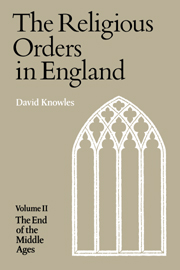Book contents
- Frontmatter
- Contents
- Preface
- List of Abbreviations
- Part One The Historical Framework
- Chap. I The opening of the period
- Chap. II Monks and canons at the university, 130c–1450
- Chap. III Patrons and architects: Ely and Gloucester
- Chap. IV Portraits of monks
- Chap. V Monks and friars in controversy
- Chap. VI Trends in speculation: Ockhamism, justification and grace
- Chap. VII Criticism of the religious in the fourteenth century
- Chap. VIII The spiritual life of the fourteenth century
- Chap. IX Developments within the orders: I
- Chap. X Developments within the orders: II
- Chap. XI The fortunes of the Cluniac houses and the alien priories
- Chap. XII The loosening of discipline
- Chap. XIII King Henry V
- Chap. XIV More portraits of monks
- Chap. XV The second century of visitation, 1350–1450
- Chap. XVI The spiritual life of the fifteenth century
- Part Two The Institutional Background
- Appendix I Chaucer's monk
- Appendix II Henry V and the Westminster recluse
- Appendix III Regulars as bishops
- Bibliography
- Index
Chap. IV - Portraits of monks
Published online by Cambridge University Press: 28 January 2010
- Frontmatter
- Contents
- Preface
- List of Abbreviations
- Part One The Historical Framework
- Chap. I The opening of the period
- Chap. II Monks and canons at the university, 130c–1450
- Chap. III Patrons and architects: Ely and Gloucester
- Chap. IV Portraits of monks
- Chap. V Monks and friars in controversy
- Chap. VI Trends in speculation: Ockhamism, justification and grace
- Chap. VII Criticism of the religious in the fourteenth century
- Chap. VIII The spiritual life of the fourteenth century
- Chap. IX Developments within the orders: I
- Chap. X Developments within the orders: II
- Chap. XI The fortunes of the Cluniac houses and the alien priories
- Chap. XII The loosening of discipline
- Chap. XIII King Henry V
- Chap. XIV More portraits of monks
- Chap. XV The second century of visitation, 1350–1450
- Chap. XVI The spiritual life of the fifteenth century
- Part Two The Institutional Background
- Appendix I Chaucer's monk
- Appendix II Henry V and the Westminster recluse
- Appendix III Regulars as bishops
- Bibliography
- Index
Summary
THOMAS DE LA MARE
The first monk to be taken as a representative of his age is the long-lived abbot of St Albans, Thomas de la Mare, who held office for almost half a century and whom a distinguished modern historian has named the greatest in the long line of abbots of the premier house of England. Certainly, whether we assent to this judgement or not, it will not be disputed that Abbot de la Mare displays, magnified as it were to several dimensions, the qualities to be found in numerous prelates of his age; he occupies, in fact, very much the same place in monastic history as does Samson of Bury two centuries earlier, and had he found, like Samson, a vates sacer with a memory and a naïveté rivalling those of Jocelin of Brakelond, his name would doubtless be as familiar to his countrymen to-day.
His two predecessors had been men of marked individuality, if no more, and had shown, each in his own way, how such a house as St Albans could foster and give expansion to talents of all kinds that might otherwise have failed to blossom. Richard of Wallingford (b. 1291), the son of a blacksmith, was adopted, no doubt on account of his manifest promise, by the then prior of Wallingford, who sent him to Oxford—the Oxford of Duns Scotus—where he passed successfully through the arts course (1308–14), and at the age of twenty-three asked for the monastic habit at St Albans.
- Type
- Chapter
- Information
- Religious Orders Vol 2 , pp. 39 - 60Publisher: Cambridge University PressPrint publication year: 1979

